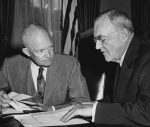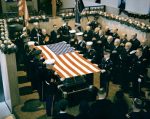 Dwight Eisenhower (1890-1969) was the 34th president of the United States, serving between January 1953 and the inauguration of John F. Kennedy in January 1961. Dwight David Eisenhower was born in Texas, the son of a storekeeper who relocated to Kansas shortly after his son’s birth. The young Eisenhower developed a keen love of history, particularly military history, and set himself on joining the army. He worked for several years after graduating high school, then in 1911 was accepted into West Point. He graduated in 1915 and was commissioned as a second lieutenant in the US Army. Eisenhower finished World War I as a brevet lieutenant colonel, though he saw no combat abroad, much to his frustration.
Dwight Eisenhower (1890-1969) was the 34th president of the United States, serving between January 1953 and the inauguration of John F. Kennedy in January 1961. Dwight David Eisenhower was born in Texas, the son of a storekeeper who relocated to Kansas shortly after his son’s birth. The young Eisenhower developed a keen love of history, particularly military history, and set himself on joining the army. He worked for several years after graduating high school, then in 1911 was accepted into West Point. He graduated in 1915 and was commissioned as a second lieutenant in the US Army. Eisenhower finished World War I as a brevet lieutenant colonel, though he saw no combat abroad, much to his frustration.
Eisenhower is perhaps best known for his military leadership in World War II. He worked in Washington initially, before transferring to London in 1942. Eisenhower was successful at strategic planning and he ascended quickly through the ranks, moving from colonel to four-star general in the space of just 22 months. In December 1943 Eisenhower was appointed Supreme Allied Commander in Europe. In this role, he oversaw the Allied invasion of continental Europe on ‘D Day’ (June 1944) and the liberation of France and western Europe from Nazi occupation. In 1945 he served as military governor of occupied Germany, before returning to the US to become Army Chief of Staff. Eisenhower’s personal view was that the Soviets were unlikely to enter a war with the United States and its allies – nevertheless, he increased military preparedness as required by the Truman Doctrine. In April 1951 Eisenhower was appointed Supreme Commander of NATO. He retired from this position in May 1952 to enter politics.

Eisenhower entered the 1952 presidential race as the Republican candidate, choosing Richard Nixon as his running mate. Trading on his wartime popularity with the slogan “I like Ike”, Eisenhower won in a landslide, winning 55.2 percent of the vote and carrying 39 states. During Eisenhower’s two terms as president, his foreign policy was strongly influenced by Secretary of State John Foster Dulles. In the early 1950s the US expanded its nuclear arsenal, made a heavy commitment to the Korean War and signed several bilateral and multilateral treaties. Later, Eisenhower sought agreements to limit arms production and nuclear proliferation. In 1953 his administration negotiated a ceasefire in the Korean War – but around the same time became enmeshed in another Asian conflict, installing the pro-Western Ngo Dinh Diem regime in South Vietnam. Eisenhower resisted deploying American combat soldiers in south-east Asia, however.

Eisenhower’s presidency saw the birth of the Space Race; a significant growth in the Central Intelligence Agency (CIA) and its involvement in foreign coups; and an increase in espionage and surveillance activities against Soviet interests. The rise of Nikita Khrushchev offered some potential for better US-Soviet relations. Khrushchev visited the US in September 1959 and his meetings with Eisenhower were cordial and productive. This goodwill was shattered by the capture of Gary Powers and his U-2 spyplane in May 1960. Eisenhower left office in January 1961, handing the presidency to John F. Kennedy. In his farewell speech the outgoing president warned of the dangers the “military-industrial complex”, a coalition of military commanders and weapons manufacturers who had a vested interest in keeping America on the brink of war. Eisenhower retired to his farm in Gettysburg, Pennsylvania, where he penned his memoirs and gave occasional advice to presidents Kennedy and Lyndon Johnson. He died from heart failure in March 1969 and was buried in his Kansas hometown.

1. Dwight David Eisenhower was an American general, an Allied military commander and, between 1953 and 1960, the 34th president of the United States.
2. Eisenhower joined the US Army in 1915. A colonel at the outbreak of World War II, he moved quickly through the ranks, becoming a four-star general in just two years.
3. Eisenhower was instrumental in planning and overseeing the ‘D Day’ amphibious landings that helped liberate Europe from Nazism. This made him a war hero back in the US.
4. He served as Supreme Commander of NATO before winning the 1952 presidential election as a Republican candidate. He served two full terms as president.
5. Eisenhower’s presidency coincided with the first decade of the Cold War and included the end of the Korean War, initial US involvement in Vietnam, the expansion of America’s nuclear arsenal, the growth of the CIA and its covert activities, the first Berlin crisis and the Powers-U2 spyplane affair.
Content on this page is © Alpha History 2018-23. This content may not be republished or distributed without permission. For more information please refer to our Terms of Use.
This page was written by Jennifer Llewellyn and Steve Thompson. To reference this page, use the following citation:
J. Llewellyn & S. Thompson, “Dwight Eisenhower”, Alpha History, accessed [today’s date], https://alphahistory.com/coldwar/dwight-eisenhower/.
